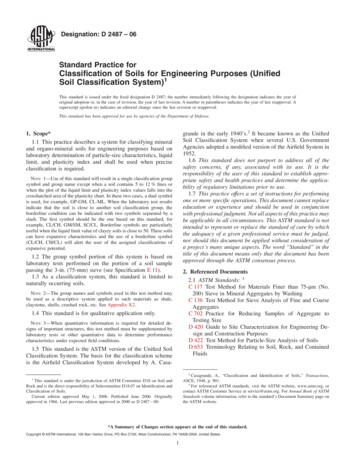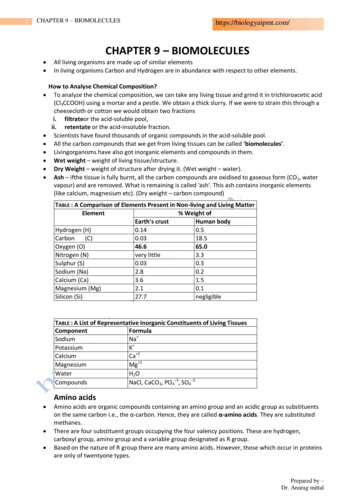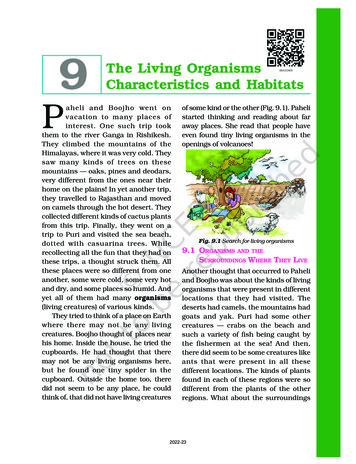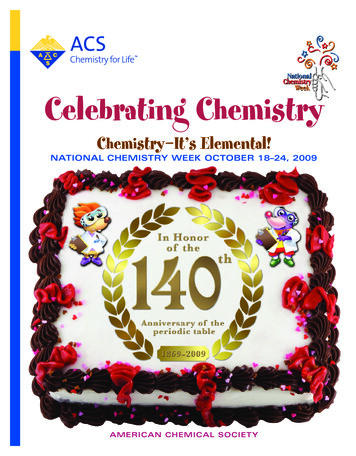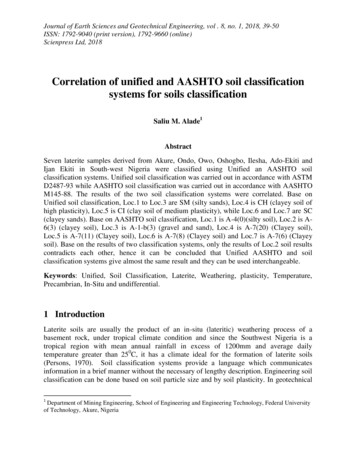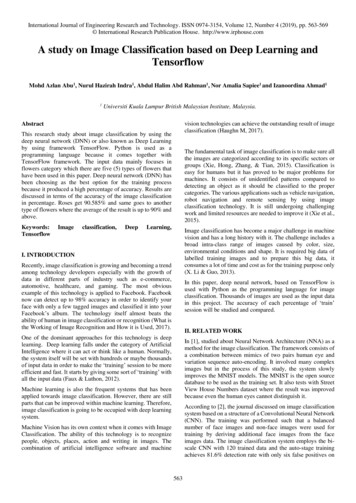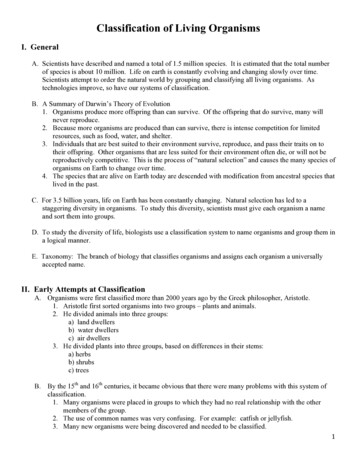
Transcription
Classification of Living OrganismsI. GeneralA. Scientists have described and named a total of 1.5 million species. It is estimated that the total numberof species is about 10 million. Life on earth is constantly evolving and changing slowly over time.Scientists attempt to order the natural world by grouping and classifying all living organisms. Astechnologies improve, so have our systems of classification.B. A Summary of Darwin’s Theory of Evolution1. Organisms produce more offspring than can survive. Of the offspring that do survive, many willnever reproduce.2. Because more organisms are produced than can survive, there is intense competition for limitedresources, such as food, water, and shelter.3. Individuals that are best suited to their environment survive, reproduce, and pass their traits on totheir offspring. Other organisms that are less suited for their environment often die, or will not bereproductively competitive. This is the process of “natural selection” and causes the many species oforganisms on Earth to change over time.4. The species that are alive on Earth today are descended with modification from ancestral species thatlived in the past.C. For 3.5 billion years, life on Earth has been constantly changing. Natural selection has led to astaggering diversity in organisms. To study this diversity, scientists must give each organism a nameand sort them into groups.D. To study the diversity of life, biologists use a classification system to name organisms and group them ina logical manner.E. Taxonomy: The branch of biology that classifies organisms and assigns each organism a universallyaccepted name.II. Early Attempts at ClassificationA. Organisms were first classified more than 2000 years ago by the Greek philosopher, Aristotle.1. Aristotle first sorted organisms into two groups – plants and animals.2. He divided animals into three groups:a) land dwellersb) water dwellersc) air dwellers3. He divided plants into three groups, based on differences in their stems:a) herbsb) shrubsc) treesB. By the 15th and 16th centuries, it became obvious that there were many problems with this system ofclassification.1. Many organisms were placed in groups to which they had no real relationship with the othermembers of the group.2. The use of common names was very confusing. For example: catfish or jellyfish.3. Many new organisms were being discovered and needed to be classified.1
C. In response to the need for a better system of classification, the Swedish naturalist, Carolus Linnaeus,developed the system of classification that we still use today.III. Carolus Linnaeus (1707-1778)1. Linnaeus set up a classification system based on structural similarity. He thought that the organismsthat looked alike were the most closely related.2. Linnaeus developed a system that placed an organism in a particular group and assigned it a scientificname.3. He developed a naming system called binomial nomenclature that is still in use today.4. Binomial Nomenclature: The system of assigning a scientific name that consists of two parts.5. He first divided all organisms into large groups that he called kingdoms. He based his classification ontwo kingdoms: plant and animal.6. A kingdom would be further subdivided into smaller groups. Each subdivision of a kingdom is called aphylum in the animal kingdom, or a division in the plant kingdom.7. Each subset was further subdivided until he had developed 7 levels of classification.8. Levels of peciesa) Organisms are placed in the same species if they can mate and produce fertile offspring.b) A species contains only one type of organism.NOTE: In the system developed by Linnaeus, the kingdom was the biggest, broadest group. Morerecently scientists have added an additional level above the kingdom called a “domain”.IV. Rules of Binomial Nomenclature (Linnaeus)A.B.C.D.E.The scientific name always consists of two words: the genus and the species.All scientific names are in Latin. It is understood by all scientists.The genus name is always capitalized. The species name is never capitalized.The two names are always written in italics or underlined.No two organisms can have the same name.2
V. Modern TaxonomyA. Phylogeny1. Modern taxonomists consider the phylogeny of an organism when attempting to classify it.2. Phylogeny is the evolutionary history of an organism.3. To show the evolutionary relationship between different groups of organisms, scientists constructphylogenic trees.4. A phylogenetic tree is a family tree that shows the evolutionary relationships thought to existamong different groups of organisms.The phylogenetic tree to the right shows a fewof the phyla of the Animal Kingdom.What is the common ancestor of all organismsshown on this tree?Are the Cnidarians more closely related to thesponges or to the comb jellies (Ctenophores)?What is the closest relative to the Rotifers?What does a branch point represent?B. Traditionally, the morphology (structure) of the organism was the basis for its classification. Moderntaxonomy now takes into account other types of evidence when attempting to classify an organism.VI. Modern Taxonomy is Based On:A. Morphology (Structural Similarities)1. Morphology is classification based on the structures possessed by the organism.2. This was the basis for Linnaeus’ system of classification.3. The average person would use color and size, but these are the least important in classification.4. Homologous structures: Have same structure, but different functions. Example: The bonesfound in the wing of a bird, the wing of a bat, the forearm of a human and the flipper of a whaleare homologous to one another.5. Analogous structures: Similar in function but not in structure. Analogous structures are notderived from a common ancestor. Example: The wing of a bird and the wing of a butterfly havethe same function, but there is nothing in common in their structure.6. Vestigial Structure: A structure that is reduced in size and seems to be "left over" from a previousancestor. Example: Appendix7. The greater the number of homologous structures two organisms share, the more closely relatedthey are thought to be.3
B. The fossil record gives us many clues as to the morphology of ancient species, but it is an incompleterecord. Other lines of evidence must be considered when classifying an organism. Below are 5additional areas of consideration.C. Cellular Organization1. Similarity in cell structures provides evidence that organisms may be related.2. Examples: What kinds of plastids are present? Does the cell possess a nucleus? Is there a cellwall present? What is the cell wall composed of?D. Evolutionary Relationships1. Fossils show that organisms alive today are similar to organisms that are now extinct.2. Example: 25 breeds of dogs all came from a wolf-like ancestorE. Biochemical Similarities1. Similarities of chemical compounds found within cells can be used as evidence to showrelationships between organisms.2. A comparison between the proteins of two organisms serves as a “molecular clock.” Simplemutations occur all the time, causing slight differences in the DNA and the proteins being built.When the proteins of two different organisms are compared, the number of differences in aminoacid sequences is a clue as to how long ago two species diverged from a shared common ancestor.F. Genetic Similarities1. Do the two organisms being compared have the same number of chromosomes? The same type ofchromosomes?2. Two organisms that bear no resemblance to one another anatomically may still be related to oneanother. Two different “looking” organisms may have similar genes in their DNA.3. Example: Humans have a gene that is the code for building a protein called myosin. This proteinis a primary component of our muscles. Yeasts (which have no muscles) have the same gene. Thegene in yeasts produces the same myosin protein as it does in humans. In yeasts, this protein isused to materials around the inside of the cell.4. This genetic similarity is an indication that yeasts and humans share a common ancestry.G. Embryological Similarities1. Similarities in embryological development provide evidence of phylogenetic relationships.2. Some organisms show no similarities as adults, but are very, very similar as embryos.VII. CladisticsA.B.C.D.E.F.Cladistics is a relatively new method of classifying organisms.Cladistics uses features called “shared derived characters” to establish evolutionary relationships.A “derived character” is a feature that evolved only within the group under consideration.An example might be the feathers of birds. Birds are the only animals to have feathers. It is thereforeassumed that feathers evolved within the bird group and were not inherited from a distant ancestor.Shared derived characters are strong evidence of common ancestry between the organisms that sharethem.Cladogram: A diagram that shows the evolutionary relationships among a group of organisms.4
G. CladogramWhat are the “derived characters” shown in this cladogram? Amniote egg, openings in skull formuscles, hair, live birth, and placenta.Which group on the cladogram arose first? AmphibiansDo amphibians have an amniote egg? NoDo turtles have an amniote egg? YesWhich two groups on the cladogram seem to be most closely related? Birds and dinosaursList the groups that have hair. Monotremes, marsupials, and placental mammals.List the groups that give live birth to their young. Marsupials and Placental MammalsWhat are the derived characters of the monotremes? Amniote egg, openings in skull, hair,Which two groups have the most shared derived characters? Marsupials and Placental mammals5
VIII. Kingdoms and DomainsA.As new discoveries have been made, the systems of classification had to be changed. The firstattempt at scientific classification was Linnaeus with his 2-kingdom system. Since the time ofLinnaeus, many changes have been made in the ways that scientists classify organisms.B.As we discuss these changes in classification, fill in the table eAnimaliaAnimaliaAnimaliaAnimaliaC. A change to the 5 and 6-kingdom systems is the evidence that all living things seem to fall naturallyinto three broad groups. In recent years, this led to the establishment of a 3-domain system.Domains are essentially super kingdoms, a taxonomic level even higher than the kingdom level.The 6-kingdom KingdomFungiKingdomAnimaliaDomain Eukarya(eukaryotes)The 3-domain systemThe domain Bacteria contains the Kingdom Eubacteria.The domain Archaea contains the Kingdom Archaebacteria.The domain Eukarya contains the Kingdoms Protista, Plantae, Fungi, and Animalia.6
IX. Kingdom Comparison!All Living aArchaebacteriaProtistaFungiPlantaeAnimaliaCell ryoticeukaryoticCellStructuresCell wallscomposed ofpeptidoglycansCell walls donot containpeptidoglycansCell wallscomposed ofcellulose insomeorganisms.Cell walls arecomposed ofchitin.Cell wallscomposed ofcellulose.No cell walls.Nochloroplasts.Chloroplastsare present.Most nization UnicellularFoodGetting?ExamplesUnicellularSome havechloroplasts.Mostunicellular.Somecolonial.Some HeterotrophStrepStaphE. coliMethanogensAmebaParameciumAlgaeSlime moldsGiant aringplantsFloweringplantsNochloroplasts.7
X. Barriers between the species: What factors keep the species apart?A. Physical Characteristics1. Mating is impossible under natural conditions for many organisms.B. Mating occurs, but the offspring do not survive.1. Bullfrog eggs may be fertilized by the sperm of the leopard frog. The eggs develop to a point, butdo not survive. There is too much difference in the chromosomes.C. The offspring may survive but they are not fertile.1. Example: horse donkey muleD. Geographical Barriers1. Many organisms simply do not come into contact with one another.E. Behavioral Barriers1. Many organisms, especially in the animal kingdom, will not mate unless certain behaviors areexhibited.XI. Classifying Organisms Using a Dichotomous KeyA. How to use a dichotomous key:1. Read the first pair of statements. Decide which statement (1a or 1b) applies to the organism youare trying to identify.2. Follow the direction at the end of the statement.3. Continue reading the paired statements and following the directions until you determine theidentity of the organism.B. Use the following dichotomous key to identify the following leaves:8
1a. The leaf is a compound leaf; it is divided into leaflets . Go to step 21b. The leaf is a simple leaf; it is not divided into leaflets . Go to step 42a. Leaflets are palmate; they are attached at one central point Buckeye2b. Leaflets are pinnate; they are attached at several points . Go to step 33a. Leaflets taper to pointed tips . . Pecan3b. Leaflets are oval with rounded tips . Locust4a. Veins branch from one central point . Go to step 54b. Veins branch from a main vein in the middle of the leaf . Go to step 65a. The leaf is heart shaped . Redbud5b. The leaf is star shaped . Sweet gum6a. The leaf has a jagged edge Birch6b. The leaf has a smooth edge . Magnolia1 – Magnolia2 – Buckeye3 – Redbud4 - Pecan5 – Birch6 – Locust7 – Sweet GumCreated by Amy Brown – Science StuffCopyright Amy Brown (aka Science Stuff)All rights reserved by author.This document is for your classroom use only.This document may not be electronically distributed or posted to a web site.9
C. A change to the 5 and 6-kingdom systems is the evidence that all living things seem to fall naturally into three broad groups. In recent years, this led to the establishment of a 3-domain system. Domains are essentially super kingdoms, a taxonomic level even higher than the kingdom level. The 6-kingdom system Kingdom Eubacteria Kingdom

